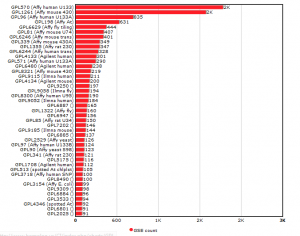
In our Trends Section - II
In our trends section, we show a list of GEO platforms used by researchers most often. The list is self-generated by a script and counts the number of submitted experiments (GSE) for each platform (GPL).

When we first generated the table one year back, we annotated the top GPLs with descriptive tags such as ‘Affy mouse’, ‘Agilent human’ to assist readers. The annotations were not updated since then, and therefore the GPLs without the tags in the above figure are new entries to the top rank. They are descriptive of new interests transcriptomics researchers developed over the last year or so. Let us go through them one by one.
GPL9250: Illumina Genome Analyzer II (Mus musculus) - high-throughput sequencing NCBI GEO
GPL6887: Illumina MouseWG-6 v2.0 expression beadchip - oligonucleotide beads NCBI GEO
GPL6947: Illumina HumanHT-12 V3.0 expression beadchip - oligonucleotide beads NCBI GEO
GPL7202: Agilent-014868 Whole Mouse Genome Microarray 4x44K G4122F - in situ oligonucleotide NCBI GEO
GPL6885: Illumina MouseRef-8 v2.0 expression beadchip - oligonucleotide beads NCBI GEO
GPL5175: [HuEx- 1_0-st] Affymetrix Human Exon 1.0 ST Array [transcript (gene) version] NCBI GEO
GPL8490: Illumina HumanMethylation27 BeadChip (HumanMethylation27_270596_v.1.2) NCBI GEO
GPL9309: Illumina Genome Analyzer (Caenorhabditis elegans)
high-throughput sequencing NCBI GEO
GPL6884: Illumina HumanWG-6 v3.0 expression beadchip - oligonucleotide beads NCBI GEO
GPL3533: [Porcine] Affymetrix Porcine Genome Array NCBI GEO
GPL6801: [GenomeWideSNP_6] Affymetrix Genome-Wide Human SNP 6.0 Array - in situ oligonucleotide NCBI GEO
GPL2025: [Rice] Affymetrix Rice Genome Array
- in situ oligonucleotide NCBI GEO
Observations:
1. Illumina bead chips are getting very popular among researchers. The pace of growth is even faster than high-throughput sequencing.
2. This is the first time a methylation-array joined the rank of highly used transriptomics platforms. It suggests that the researchers are now venturing out of traditional stronghold of expression arrays to other areas.
3. The set used to be dominated by human, mouse and other model organisms, but this is the first time two new organisms - pork and rice - entered the fray. They are the results of globalization in transcriptional research.